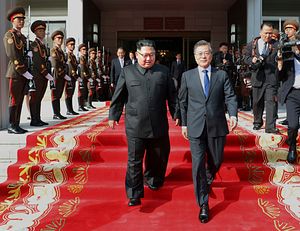South Korean President Moon Jae-in, flanked by several cabinet ministers and business leaders, will cross the inter-Korean border tomorrow to head to Pyongyang for a historic fifth inter-Korean summit. Ever since the April 27 meeting between the two Korean leaders at Panmunjom and their brief encounter in May following U.S. President Donald J. Trump’s decision to cancel the June U.S.-North Korea summit, a third summit has been on the cards.
For Moon and North Korean leader Kim Jong Un, the next few days will serve as an important moment to see through the implementation of the promises made at Panmunjom, especially as difficulties have made themselves apparent, ranging from the limits of economic cooperation under the extensive international sanctions regime on North Korea and the ever-present issue of denuclearization.
This week’s summit is largely being framed — especially in the United States — as an opportunity for Moon to mediate between the United States and North Korea on denuclearization. This isn’t entirely wrong; the Blue House has even been pitching the summit around this objective. Ever since Trump’s decision to call off a scheduled trip by Pompeo to Pyongyang at the end of August, the United States and North Korea have returned to an impasse on denuclearization.
Even as Trump praised Kim for the gesture of leaving nuclear-capable systems out of a military parade to commemorate the 70th anniversary of North Korea’s founding, there’s little evidence that Washington and Pyongyang have found a common understanding of what “denuclearization” itself means. Moon alone is unlikely to extract any meaningful concessions from North Korea on this front beyond securing a renewed commitment from Kim to work toward “complete denuclearization of the Korean Peninsula,” as he did in the Panmunjom declaration.
This summit, like the Panmunjom summit, however, will primarily be about the promise of inter-Korean cooperation. The two Koreas opened a joint liaison office last week, despite U.S. concerns about sanctions violations in the process. The upcoming summit might give thrust now to coordinated and serious conventional arms control measures between the two sides. South Korean National Security Advisor Chung Eui-yong, who traveled to Pyongyang for a coordination meeting where he met Kim, has been vocal on this point.
Both Koreas have agreed to “continue make progress in the ongoing inter-Korean talks to ease military tensions and decided to reach an agreement at the inter-Korean summit on concrete plans to establish mutual trust and prevent military clashes,” Chung said after his trip to Pyongyang. “I would say that the two Koreas are going beyond military trust-building, and are in effect attempting to engage in a preliminary level of operational arms control,” he added recently.
The two specific areas of progress are bilateral measures along the Northern Limit Line — the disputed West Sea maritime boundary — and other measures along the Demilitarized Zone. Last week, the two sides held working-level military talks to reduce tensions. For Moon, who’s long been vocal about the pursuit of peace, walking away from Pyongyang with a powerful joint declaration on military-to-military talks and cooperation would be a powerful gesture.
This becomes all the more important given the ongoing obstacles to grand economic gestures. At Panmunjom, Moon’s handing over to Kim of a USB stick loaded with grand economic plans was understandably touted as a major moment, but none of that can go ahead with sanctions relief, which follows in the aftermath of nuclear disarmament in the eyes of the international community. Now, Moon will be flanked by the chiefs of several prominent South Korean chaebol, including Samsung Electronics, Hyundai Group, LG Group, SK Group, and others.
As much as the Blue House might seek to build on the promises given to North Korea at the Panmunjom summit, little can be done without sanctions relief. As a result, the outcome of the upcoming meeting is likely to be symbolic and foundational — a point that might frustrate Pyongyang, which has vocally called for sanctions relief and progress on the economic front in the months since the first inter-Korean summit this year. Indeed, other possible concessions, including further inter-Korean family reunions, may be held up by the economic promises that South Korea will be able to offer.
The most significant issue to watch for — and the possible linchpin connecting all of the above and determining new possibilities in the months ahead — is what progress, if any, Moon and Kim can make on the issue of a symbolic declaration to end the Korean War. This is what both Koreas appear to be eagerly in pursuit of and something that North Korea, at least, believed Trump was willing to conclude quickly after the Singapore summit. Per the South Korean Unification Ministry, this declaration remains an objective for the end of 2018, leaving little time on the clock. Without the declaration, progress toward a “peace regime” on the peninsula — a goal set out in both the Panmunjom and Singapore summit declarations — will remain frozen.
It’s here that Moon’s travel plans after the next days in Pyongyang take on newfound urgency. He will head to New York, where he will attend the United Nations General Assembly’s general debate and meeting Trump. If he leaves Pyongyang with sufficient assurances on denuclearization in-hand, he might be able to persuade the U.S. president to follow through. Kim is unlikely to submit to any assurance of unilateral disarmament — something the North Korean regime has made clear throughout the year. But Moon may be able to extract some kind of assurance formalizing North Korea’s self-declared moratorium on nuclear and missile-testing or — though less likely — a promise to provide an inventory of North Korea’s nuclear arsenal.
It’s been a whirlwind year for diplomacy on the Korean Peninsula. The next few days in Pyongyang will set the trajectory for where inter-Korean rapprochement and U.S.-North Korea diplomacy are likely to go in the final months of 2018.

































